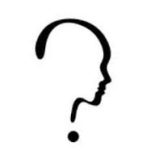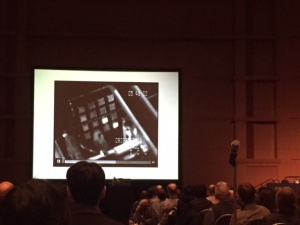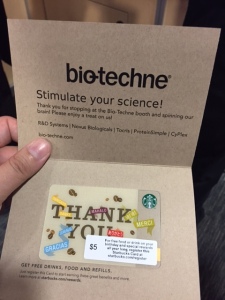SfN2014: Day3 – Attention/Reward Symposium, More Exhibit Fun, Perception/Imagery Posters
It’s the third day of the conference. I didn’t attend a special lecture. So no intro by the SfN president and so no idea how many people are now registered. So let’s describe it as the very technical term of a whole lot (yesterday was already over 30,000).
Unfortunately the weather is not great: cold and rainy. But I’m sticking to walking to the conference because really, it’s only a 10 minute walk. Even with a quick detour to Starbucks it’s not bad. And it was mainly drizzle this morning. But then the sky really opened up and rained pretty hard later in the morning and just as we went to lunch.
But the science must go on rain or shine…
And armed with the super cool pen from my hubby, my notes are super organized.
That’s right… multiple colors in one pen! Love these types of pens!
Attention/Reward Symposium
I arrived a little early for my first event, Symposium on Attention, Reward and Information Seeking. This is one of the larger meeting rooms and really, it looked pretty cool while empty. This symposium was to highlight recent research in humans and nonhuman primates supporting a view of attention as a decision that is made to help optimize sampling information and behavior.
Dr Jacqueline Gottlieb opened the symposium outlining the problem. When the process of seeing and acting in the world is broken down (such as when someone walks down the street) they must be aware of their surroundings as well as their intentions. This involves a process of information sampling to develop a sensory representation, then deliberation on this information and then action. The info sampling & sensory representation portion are the attention part of the break down, where we encode information. The deliberation and action portion are the decision part, where we plan. There is a gap in between these two parts where questions around how we regulate behavior arise. When and which objects do we sample? In our vision, eye movements, called saccades, are how we rapidly sample visual information from our environment. So how do we coordinate this sampling with a task?

Dr. Mary Hayhoe continued the conversation speaking about the control of attention by reward and uncertainty in the context of behavior. As you walk down the street and encounter obstacles like people and curbs and directions for your destination, how do you decide the next target to direction your eye gaze to? How we make transitions from target 1 to 2 to 3 represents our priority map. Behavior involves a set of tasks and gaze control involves choosing which task you should be attended to at what moment. There are rewards in the choice of the target that can be both explicit and implicit (like not tripping on a curb). There is also a role for uncertainty in eye gaze given that in the real world, we take in a lot of information all at once. So a lot of information is missing (gaze is focused, peripheral resolution is low, can’t attend to all things, position is constantly updating, visual memory decay). So acquisition of information is scheduled on basis of the task: follow path, avoid objects, retrieve targets. The rewards and uncertainties we experience change what we pay attention to.
Dr. Okihide Hikosaka then spoke on learned attention and basal ganglia mechanisms. He has some very interesting work (seen in above image) on how the process of gaze -> action -> reward are modulated by skill, memory, visual search and disease. In the first portion of his talk, he spoke of a paradigm using monkeys playing a game where they must follow/touch a pattern of lights in order to receive a reward. “Monkeys love this game, even when we forget to give a reward they continue to play.” In this paradigm, he’s able to model anticipatory saccades. As the monkey learns the patterns, their gaze gets better at predicting where to look. Gaze and action are learned together, reactive to proactive. In nature/the real world, we are surrounded by many objects. It takes time to find the good ones. Like when you go to the store and look for the vegetable you want, this requires object skill and action skill. But what attracts us to find it? By assigning a manipulating the reward values of objects, he finds he can predict high valued objects by where gaze goes, we attend to high value objects more than lesser value. And this involves special circuitry in the basal ganglia, leading to interesting research for different disorders such as Parkinson’s or even drug addiction.
Dr. Gottlieb then got up to give a talk on how cue weighting based on reward and expected information have an effect on attention, asking how do we recognize important steps in the process of sampling and acting? To do this, she studies the lateral intraparietal area of the brain which is selective for attention-worthy stimuli. But how are decisions made? How does the brain compute it? It is not stereotypes, but based on expected rewards and expected information. As we sample the world around us for information, what guides the sampling? Cues… expected gains in reward or information. She finds that information sampling has privileged status in decision chains. Our brains distinguish informative from uninformative and generates preparatory responses to help us process information.
Dr. Antonia Rangel took a slightly different perspective from the other speakers with a background in neuroeconomics. He started by talking about simple decisions. When shown an object, simply ask do you want it? How much do you want it? Simple, 1 target and a yes/no question. In real life, like a supermarket, we encounter a full range of choices. So while it’s not exactly representative, it can still be informative to look at simplistic paradigms. He asks: 1) Does attention affect choice? 2) What drives attention during choice? To study this he shows subjects two objects, one on the left, one on the right. Gives them some free time to examine them on the screen while they are eye tracked for eye fixation (attention) then asks them to make a choice to study the relationship between fixation (attention) and choice. And he finds what he calls the attentional drive diffusion model by utilizing 3 basic psychometrics: choice curves, reaction times, and number of fixations. It turns out that we are more likely to choose the last thing we saw, the items we spend more time looking at and more recently look at are overweighted… unless… the other choice is much much better. This is an attentional bias that allows us to predict choice based on these biases. Is that just laziness?
Lunch
So today was special because I was able to meet up with 3 ladies that I knew back in grad schools days. We hadn’t seen each other in many years (all the way up to probably 9 years!). So it was great to catch up, gossip and enjoy some great food.
More Exhibit Fun
One of the ladies, Katie, now works at R&D Systems/Biotechne and brought us by her booth. Which is quite a lovely set up. But also super fun. Katie helped design a spin the wheel game. You spin the wheel and whatever brain part you land on dictates the type of award you get. I was lucky and got a free choice, so I obviously chose a Starbucks gift card. There were some other cool gifts as well.
The fun didn’t end there. Came across this cool scene at Ripple where attendees were using biofeedback to try to beat one another at moving a ball closer to themselves (by being more relaxed).
And then I stopped by the Biopac booth to check on the latest tech (we already use biopac at my work) and got to try out their VR set up with other biometrics.
Pretty cool!
And then it was poster time again.
Posters: Perception/Imagery
One of the posters that caught my eye was from the University of Scranton where they analyzed the faces of homosexual and heterosexual celebrities for morphological comparisons. Here I witnessed a bit of an awkward conversation between the presenter and an attendee that didn’t seem so pleased. This happens for sure. And this topic was surely inflammatory.
But I had a great conversation with Natalie Gallagher of Georgetown Univ and with funding from the American Legacy Foundation on “Young adult smokers’ reactions to graphic warning labels and tobacco advertising”. For this study the looked at how effective warning labels were on decreasing wanting of cigarettes in smokers when seeing warning labels with/without imagery (like medical consequences) and branded/unbranded. While branding didn’t have an effect, graphics significantly affected the rate of wanting to quit. Then to examine the effect of an advertising task (appetitive test) they looked at the effect of seeing ads for either cigarettes (preferred brand), e-cigarettes, or a control (snack food) on the rate of wanting to quit smoking. Both cigarette and e-cig ads had the same affect on increasing wanting to smoke over the control. Natalie thinks it would be interesting to extend this work into looking at how this would affect non-smokers, particularly non-smokers exposed to e-cigarette advertisements.
Great day! I’m pooped! Out to dinner tonight with friends from my postdoc and then turning in early as I will be presenting tomorrow. Wish me luck! @nerdoscientism on twitter!









